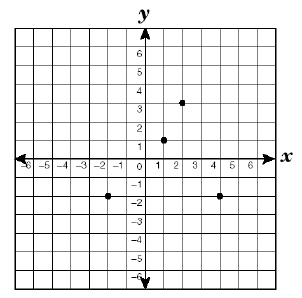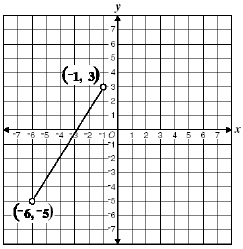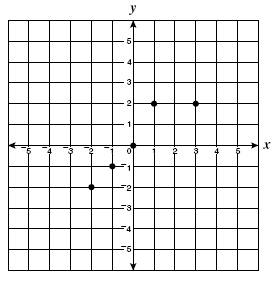|
|
|
1.
|
Loki said the following graph does not represent a function of
x.
Which pair of points could
Loki use to prove her statement is correct? A) | (-3, 4) and (-3, -4) | C) | (-3, 4) and (4, -3) | B) | (-4, 3) and (4, 3) | D) | (-5, 0) and (5,
0) |
|
|
|
2.
|
The ordered pairs in the sets shown below are of the form (x, y).
In which set of ordered pairs is y a function of x ?
A) | {(-3, 4), (1, -9), (1, 4)} | C) | {(1, -1), (2, -1), (2,
-3)} | B) | {(0, -5), (0, 4), (0, 5)} | D) | {(0, 1), (1, -1), (1, 0)} |
|
|
|
3.
|
Which of the following sets of ordered pairs is a function?
A) | {(2, 1), (2, 2), (3, 4), (5, 6)} | C) | {(1, 2), (2, 2), (3, 3), (2,
4)} | B) | {(-2, -1), (1, 2), (3, 4), (1, 5)} | D) | {(1, 1), (2, 1), (3, 2), (4,
4)} |
|
|
|
4.
|
Which of the following tables does not represent a
function?
|
|
|
5.
|
The ordered pairs in the sets shown below are of the form (x,
y). In which set of ordered pairs is y not a function of x
?
A) | {(1, 4), (2, 4), (3, 4), (4, 4)} | C) | {(11, 2), (12, 4), (13,
6)} | B) | {(2, 0), (4, 1), (6, 2), (8, 3)} | D) | {(-6, 37), (-6, 10), (-5,
26)} |
|
|
|
6.
|
Which graph apparently represents a function of x?
|
|
|
7.
|
What is the domain of the function shown? A) | All integers | C) | All natural numbers | B) | All real numbers | D) | All whole
numbers |
|
|
|
8.
|
The ordered pairs in the sets shown below are of the form (x, y).
In which set of ordered pairs is y a function of x?
A) | {(-6, 12), (1, 8), (1, 13)} | C) | {(7, -1), (7, -2), (7,
-3)} | B) | {(0, 2), (0, 4), (4, 0)} | D) | {(1, 3), (2, 4), (3, 5)} |
|
|
|
9.
|
Which of the following does not represent a function of x?
|
|
|
10.
|
What is the apparent domain of the | relation shown of the grid? |  | | |
A) | {-2, 1, 2, 4} | B) | {-2, 1, 3} | C) | {1, 2, 3, 4} | D) | {-2, 2, 3,
4} |
|
|
|
11.
|
What is the domain of the | function of x graphed? |  | | |
A) | {all real numbers < 3} | C) | {all real numbers between -5 and
3} | B) | {all real numbers < -1} | D) | {all real numbers between -6 and -1} |
|
|
|
12.
|
The numbers in this table follow a linear pattern.
What is the missing
value?
|
|
|
13.
|
Using the same relationship between x and y as the table, what is the value of y when x is
8?
|
|
|
14.
|
Which of the following represents the graph of a function of x?
|
|
|
15.
|
Which of the following does not represent a function of x?
|
|
|
16.
|
Which of these data sets represents a function?
|
|
|
17.
|
If f(–5) = 80, which could be the equation for
f(x)?
|
|
|
18.
|
What is the range of the set of ordered pairs {(5, 4), (–2, –4),
(–5, 9), (3, 8)}?
A) | {–4, 4, 8, 9} | B) | {–5, –2, 3, 5} | C) | {–4, –2, 5,
8} | D) | {–5, 3, 5, 9} |
|
|
|
19.
|
The points in the table lie on the graph of a linear function. Which could be the function?
A) | y = 7x | B) | y = –5x – 3 | C) | y = 3x
– 1 | D) | y = –8x – 6 |
|
|
|
20.
|
(0, -3), (2, -2), (4, -1), (6, 0), . . .
These ordered pairs follow a
pattern. If (10, y) is in this pattern, what is the value of y?
|
|
|
21.
|
The ordered pairs in the sets shown below are of the form (x, y). In
which set is y a function of x?
A) | {(–7, –5), (–6, 5), (4, –4), (7, 6)} | C) | {(–6,
–5), (–6, 5), (–6, –4), (–6, 6)} | B) | {(–7,
–5), (4, –4), (4, 6), (7, 5)} | D) | {(–3, –5), (4, 5), (7, –4), (7, 6)} |
|
|
|
22.
|
What is the domain of the | relation plotted on the graph? |  | | |
A) | {-2, -1, 0, 1, 2, 3} | B) | {-2, -1, 0, 1, 3} | C) | {-2, -1, 1, 2} | D) | {-2, -1, 0,
2} |
|
|
|
23.
|
Which graph apparently does not represent a
function of x?
|
|
|
24.
|
A function of x consists of five ordered pairs of the form (x,
y). Four of the ordered pairs are shown
below.
(1, 9), (3, 19), (5, 29), (7, 39)
Which could be the 5th ordered pair of the function?
A) | (9, 8) | B) | (1, 49) | C) | (5, 19) | D) | (3,
9) |
|
|
|
25.
|
Which graph represents a function of
x?
|